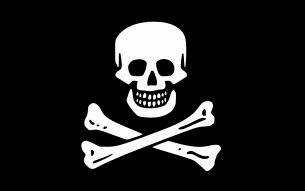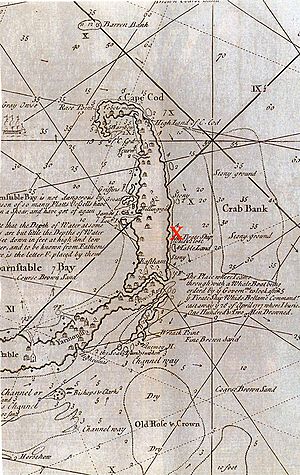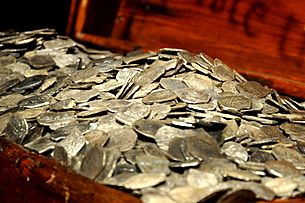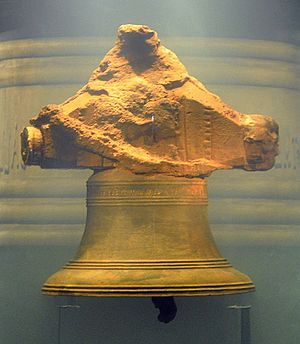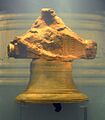Whydah Gally facts for kids
class="infobox " style="float: right; clear: right; width: 315px; border-spacing: 2px; text-align: left; font-size: 90%;"
| colspan="2" style="text-align: center; font-size: 90%; line-height: 1.5em;" | 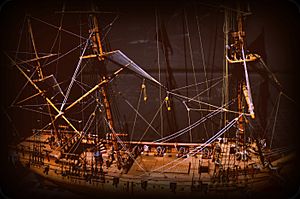
|- |Commander: |Captain Lawrence Prince |- |Chased by pirates: |Late Feb, 1717
Windward Passage |- |Surrendered /
Captured: |three days later, near the lower Bahamas
|- |Commander: |Samuel "Black Sam" Bellamy |- |Wrecked: |late night of 26 April 1717, Billingsgate, Cape Cod, Massachusetts Bay Colony |- |Discovered: |1984, by Barry Clifford |- |Authenticated: |1985, by discovery of the ship's inscribed bell and a brass placard, both inscribed with ship's name
|} The Whydah Gally (often called simply the Whydah) was a large sailing ship. It was built to carry passengers, cargo, and people across the ocean. On its first big trip, the Whydah Gally was captured by the famous pirate Captain Samuel "Black Sam" Bellamy. This began its new life as a pirate ship during the exciting time known as the Golden Age of Piracy.
Bellamy sailed the Whydah Gally along the coast of colonial America. He captured other ships as he went. On April 26, 1717, a huge storm hit the Whydah Gally. The ship was wrecked off the coast of Cape Cod, Massachusetts. Only two of the Whydah Gally crew survived. Seven other people from a smaller ship Bellamy had captured also survived. Six of these nine survivors were later punished. Two were set free because they had been forced to join the pirates. One Native American crewman was sold into slavery.
The Whydah Gally and its pirate treasure were lost for over 260 years. Then, in 1984, the shipwreck was found off Cape Cod. It was buried under 10 to 50 feet (3 to 15 meters) of sand. The wreck was spread out for four miles (6.4 km). In 1985, the ship's bell was found. It had the ship's name and maiden voyage date carved into it. In 2013, a small brass plate with the same information was found. This made the Whydah Gally the only fully proven pirate shipwreck from the Golden Age ever discovered.
Contents
- The Whydah Gally's First Life
- Captured by Pirates
- The Shipwreck
- Survivors of the Wreck
- Finding the Lost Ship
- Amazing Discoveries
- Exhibitions and Documentaries
- Images for kids
The Whydah Gally's First Life
The Whydah Gally was ordered to be built in 1715 in London, England. It was commissioned by Sir Humphrey Morice. He was a member of parliament (MP) and a well-known London merchant. The ship was a three-masted galley, meaning it had both sails and oars.
It was 110 feet (33.5 meters) long and could travel up to 13 knots (24 km/h). The ship was named Whydah Gally after a trading port in West Africa. It was built as a strong trading and transport ship.
The Whydah Gally began its first voyage in early 1716. It carried many goods from different businesses. These goods were meant to be traded in West Africa. The ship traveled along the West African coast. It went through modern-day Gambia, Senegal, Nigeria, and Benin. From Africa, it carried about 500 people, gold, and ivory to the Caribbean. There, it traded these for precious metals, sugar, and other goods. These items were then meant to be taken back to England. The ship had 18 cannons, but it could carry up to 28 in times of war.
Captured by Pirates
In late February 1717, the Whydah Gally was sailing near Cuba and Hispaniola. It was under the command of Captain Lawrence Prince. Pirates led by "Black Sam" Bellamy attacked it. Bellamy already had two ships: the Sultana and the Marianne.
After a three-day chase, Captain Prince gave up his ship near the Bahamas. There was only a small fight with cannons. Bellamy decided to make the Whydah Gally his new main ship. Some of the Whydah Gally crew stayed and joined the pirates. Many people joined pirates because they were unemployed or wanted a different life. They came from many backgrounds, including freed African people, English sailors, and Native Americans.
The flag of Samuel Bellamy's pirate crew.
As a kind gesture, Bellamy gave his old ship, the Sultana, to Captain Prince. He also gave Prince £20 in silver and gold. The Whydah Gally was then changed to be a pirate ship. Bellamy added 10 more cannons. About 150 of Bellamy's crew members were assigned to the ship. They also removed parts of the ship that made it top-heavy, like the slave barricade.
Bellamy and his crew then sailed north along the American colonies' eastern coast. They were heading for Maine. On the way, they captured or looted more ships. The Whydah Gally was caught in a storm. This storm badly damaged the ship and broke one of its masts. They made quick repairs. Later, they made bigger repairs near Nantucket Sound. Bellamy also added more than 30 cannons below deck. These cannons might have been used as extra weight to balance the ship.
They could not wipe out the North-East gales
Nor what those gales set free —
The pirate ships with their close-reefed sails,
Leaping from sea to sea.
There are different stories about where the Whydah Gally was going in its last days. Some say Bellamy wanted to visit his love, Maria Hallett, on Cape Cod. Others believe the ship's route was a mistake by the navigator. On April 26, 1717, near Chatham, Massachusetts, the Whydah Gally sailed into a thick fog. This fog was a sign of bad weather coming.
On that same day, the pirates captured a ship called Mary Anne. It was full of wine. The captain of Mary Anne refused to guide them up the coast. So, Bellamy arrested him and five of his crew. He brought them onto the Whydah Gally. Bellamy sent seven of his own men onto the Mary Anne. One of them was Thomas South, a carpenter. He had been forced to join the pirates. He hoped to escape by swimming ashore when they got close to land. As the sun set, the wind died, and the fog became very thick. Bellamy's four ships lost sight of each other.
The location of the wreckedWhydah Gallyin Wellfleet, Massachusetts, on Cape Cod.
The Shipwreck
The bad weather turned into a strong nor'easter storm. This storm had very strong winds from the east and northeast. It pushed the ship dangerously close to the sandbars of Cape Cod. The ship eventually ran aground at what is now Marconi Beach in Wellfleet, Massachusetts. At midnight, it hit a sandbar. The front of the ship was in 16 feet (4.9 meters) of water, about 500 feet (150 meters) from shore.
The storm had 70 mph (110 km/h) winds and 30 to 40-foot (9 to 12-meter) waves. The main mast broke, pulling the ship into about 30 feet (9.1 meters) of water. There, it violently flipped over. Over 4.5 tons (4.1 metric tons) of silver and gold, more than 60 cannons, and 144 people went to the ocean floor. The cannons inside the ship broke through the overturned decks. They quickly tore the ship apart. Parts of the ship, 102 bodies, and thousands of objects were scattered over a 4-mile (6.4 km) stretch of coast. One of the two surviving crew members, Thomas Davis, said that the ship broke apart very quickly.
By morning, hundreds of local people, known as "moon-cussers," were already taking things from the wreck. The governor heard about the shipwreck. He sent Captain Cyprian Southack to find any "Money, Bullion, Treasure, Goods and Merchandizes" from the ship. When Southack arrived on May 3, he saw that part of the ship was still above water. But most of the wreck was spread out along more than 4 miles (6.4 km) of shoreline. Southack reported that he had buried 102 of the 144 people lost in the sinking.
The Mary Anne also wrecked, ten miles south. Crew members who survived said the Whydah Gally carried about four and a half to five tons of silver, gold, gold dust, and jewelry. This treasure was divided into 180 sacks, each weighing 50 pounds (23 kg). They were stored between the ship's decks. Southack found some items, but very little of the huge treasure was recovered. Southack wrote that "The riches, with the guns, would be buried in the sand." After that, the exact location of the ship and its treasure was lost. It became just a legend.
Survivors of the Wreck
Of the 146 people on the Whydah Gally, only two made it to the beach alive. They were the ship's pilot, 16-year-old Miskito Indian John Julian, and Welsh carpenter Thomas Davis. All seven of Bellamy's men on the Mary Anne survived. The three original crewmen of the Mary Anne also survived. In total, nine of Bellamy's crew survived the wrecking of both ships.
They were quickly captured and put in jail. On October 18, 1717, six of them were tried in Boston. They were found guilty and sentenced to death. These men were John Brown, Thomas Baker, Hendrick Quintor, Peter Cornelius Hoof, John Shaun, and Simon van der Vorst.
Carpenters Thomas South and Thomas Davis were tried separately. They had been forced to join Bellamy's crew. They were given a choice: join the pirates or die. Because of this, they were found not guilty and saved from punishment. John Julian was not tried. Instead, he was sold as a servant. He was later punished 16 years later.
Silver from the pirate ship Whydah Gally.
On November 15, 1717, the famous minister Cotton Mather went with the six condemned men. They were taken across Boston Harbor. All six men confessed before they were punished.
Finding the Lost Ship
Barry Clifford found the Whydah Gally wreck in 1984. He used Southack's 1717 map of the wreck site. This map was like a real-life "pirate treasure map." It led to an amazing discovery. It was surprising that the Whydah Gally had been lost for over 260 years. It was found under only 14 feet (4.3 meters) of water and 5 feet (1.5 meters) of sand.
The ship's location has been a site of a lot of underwater archaeology. Over 200,000 individual items have been found there. A big discovery in 1985 was the ship's bell. It had the words "THE WHYDAH GALLY 1716" carved into it. This proved that it was indeed the Whydah Gally. It became the first pirate shipwreck ever found whose identity was confirmed without a doubt.
The bell, inscribed, "THE WHYDAH GALLY 1716".
Clifford's dive team continues to work at the site every year. Some of the items found are shown at the Expedition Whydah Sea-Lab & Learning Center in Provincetown, Massachusetts. Other artifacts have traveled across the United States. They are now at The Wydah Pirate Museum in West Yarmouth, Massachusetts.
Amazing Discoveries
One famous story about the Whydah Gally crew is about the youngest member. He was a boy named John King, about 11 years old. John actually chose to join the crew himself. This happened in November before the wreck. Bellamy had captured the ship he and his mother were on. John was so determined that he threatened to hurt his mother if he wasn't allowed to join Bellamy.
Among the items found from the Whydah Gally was a small, black leather shoe. A silk stocking and a bone were also found with it. Scientists later found that the bone belonged to a child between 8 and 11 years old. This discovery proved that the "pirate tale" about young John King was true.
Exhibitions and Documentaries
A museum exhibition called "Real Pirates: The Untold Story of The Whydah from Slave Ship to Pirate Ship" traveled across the United States from 2007 to 2014. It visited places like Cincinnati, Philadelphia, Chicago, and St. Paul. The exhibit included videos, artifacts, and live stories from actors dressed as pirates. It also had interactive activities and a model of the ship.
In one case, the museum in Tampa, Florida announced the exhibit. They linked it to the movie Pirates of the Caribbean: At World's End. Some people felt this made the ship's history seem less serious. Because of this, the museum decided to cancel the exhibit.
On May 27, 2007, a UK TV show called Pirate Ship ... Live! showed a team of divers exploring the Whydah Gally site. On January 7, 2008, the National Geographic Channel aired a two-hour documentary. It was about the ongoing work at the wreck site and included interviews with Barry Clifford.
Images for kids
Model of Whydah Gally
| History | |
|---|---|
| Name | Whydah Gally |
| Namesake | The African slave port Ouidah |
| Owner | Sir Humphry Morice |
| Operator | Private vessel |
| Laid down | 1715, London |
| Launched | 1716, London |
| Homeport | London |
| Fate | Captured by pirates |
| History | |
| Name | Whydah Gally |
| Owner | Crew of Captain/Commodore Samuel "Black Sam" Bellamy |
| Acquired | late February, 1717 |
| Homeport | Blanco Islet, B.V.I. (later re-named Bellamy Cay) Caribbean Sea |
| Fate | ran aground, capsized |
| Status | Ruins under perpetual recovery and conservation; private ownership and exclusive dive rights |
| General characteristics | |
| Type | Galley |
| Tons burthen | 300 tons BM |
| Length | 110 ft (34 m) |
| Propulsion | Sail & oar |
| Sail plan | fully rigged, 3 masts |
| Speed | 13 knots (24 km/h; 15 mph) |
| Complement | 150 men at launch; went down with 145 men & 1 boy (incl. 6 prisoners) |
| Armament | At launch: 18 active guns
Pirate upgrade: 28 active guns Recovered: More than 65, recovery ongoing |
| Notes | Whydah was the flagship of a 5-ship fleet which included the Marianne, Mary Anne, Anne, and Fisher |


